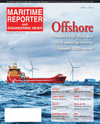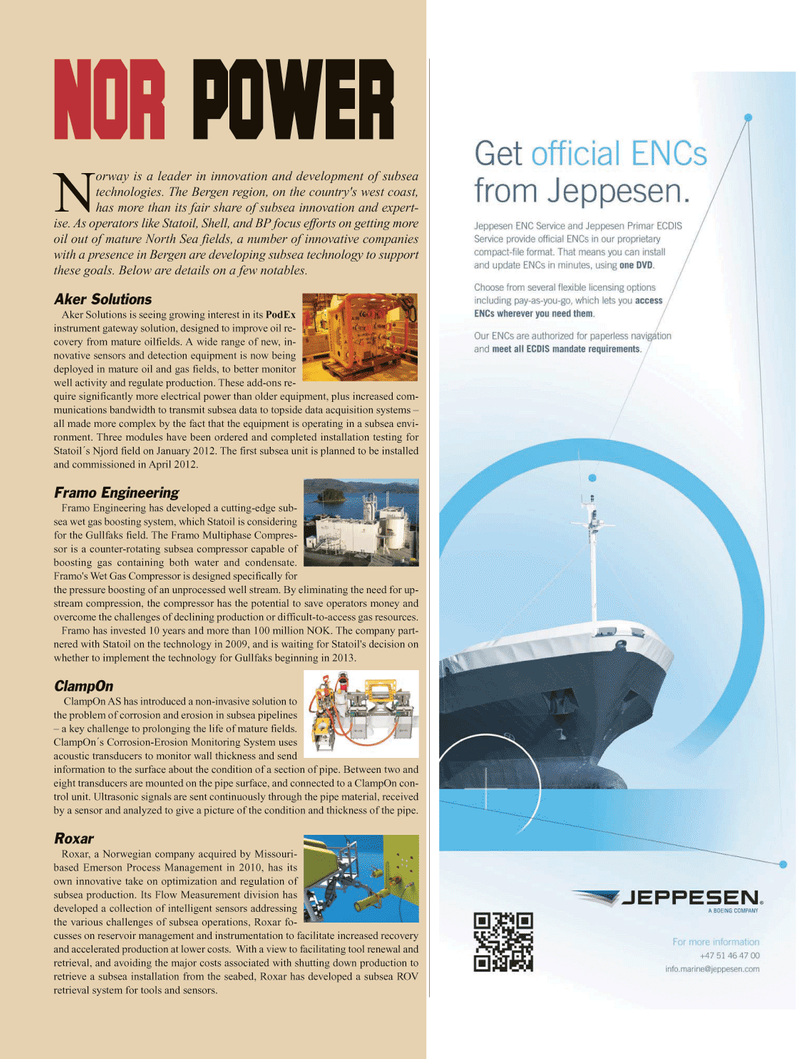
Page 59: of Maritime Reporter Magazine (April 2012)
Offshore Deepwater Annual
Read this page in Pdf, Flash or Html5 edition of April 2012 Maritime Reporter Magazine
Norway is a leader in innovation and development of subsea technologies. The Bergen region, on the country's west coast, has more than its fair share of subsea innovation and expert- ise. As operators like Statoil, Shell, and BP focus efforts on getting more oil out of mature North Sea fields, a number of innovative companies with a presence in Bergen are developing subsea technology to support these goals. Below are details on a few notables. Aker SolutionsAker Solutions is seeing growing interest in its PodEx instrument gateway solution, designed to improve oil re- covery from mature oilfields. A wide range of new, in- novative sensors and detection equipment is now being deployed in mature oil and gas fields, to better monitor well activity and regulate production. These add-ons re- quire significantly more electrical power than older equipment, plus increased com- munications bandwidth to transmit subsea data to topside data acquisition systems ?all made more complex by the fact that the equipment is operating in a subsea envi- ronment. Three modules have been ordered and completed installation testing for Statoil´s Njord field on January 2012. The first subsea unit is planned to be installed and commissioned in April 2012. Framo EngineeringFramo Engineering has developed a cutting-edge sub- sea wet gas boosting system, which Statoil is considering for the Gullfaks field. The Framo Multiphase Compres- sor is a counter-rotating subsea compressor capable of boosting gas containing both water and condensate. Framo's Wet Gas Compressor is designed specifically for the pressure boosting of an unprocessed well stream. By eliminating the need for up-stream compression, the compressor has the potential to save operators money and overcome the challenges of declining production or difficult-to-access gas resources. Framo has invested 10 years and more than 100 million NOK. The company part- nered with Statoil on the technology in 2009, and is waiting for Statoil's decision on whether to implement the technology for Gullfaks beginning in 2013. ClampOnClampOn AS has introduced a non-invasive solution to the problem of corrosion and erosion in subsea pipelines? a key challenge to prolonging the life of mature fields. ClampOn´s Corrosion-Erosion Monitoring System usesacoustic transducers to monitor wall thickness and send information to the surface about the condition of a section of pipe. Between two and eight transducers are mounted on the pipe surface, and connected to a ClampOn con- trol unit. Ultrasonic signals are sent continuously through the pipe material, received by a sensor and analyzed to give a picture of the condition and thickness of the pipe. RoxarRoxar, a Norwegian company acquired by Missouri- based Emerson Process Management in 2010, has itsown innovative take on optimization and regulation of subsea production. Its Flow Measurement division has developed a collection of intelligent sensors addressing the various challenges of subsea operations, Roxar fo- cusses on reservoir management and instrumentation to facilitate increased recovery and accelerated production at lower costs. With a view to facilitating tool renewal and retrieval, and avoiding the major costs associated with shutting down production to retrieve a subsea installation from the seabed, Roxar has developed a subsea ROV retrieval system for tools and sensors. NORPower

 58
58

 60
60
